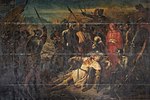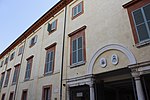The Archiepiscopal Museum (Italian: Museo Arcivescovile) is located in Ravenna, Italy, next to the Baptistry of Neon and behind the Duomo of Ravenna. In the museum relics of early Christian Ravenna are preserved, including fragments of mosaic from the first cathedral church, and the chapel of Sant'Andrea, dating from the Gothic kingdom.
The main room, on entering, contains lapidary inscriptions as HIC REQUIESCIT IN PACE VIR SBL SEDA IGNUCUS ('Here lies in peace that eminent man Seda the Eunuch'), CUBICULARIUS or 'Bedchamberlain' to Theodoric the Great, buried 541 AD. Beneath this, by the window, a reliquary for the martyred saints Quiricus and Julietta, whose remains were carried from Tarsus, the birthplace of Saint Paul, to Auxerre and from thence to Ravenna. The depictions on its four facings are in keeping with the theme of donation: Galla Placidia placed it in the church of San Giovanni Battista (not to be confused with the church of the 'Evangelista'). They are:
Christ giving the Tables of the Law to St. Peter, with Paul standing by him;
Daniel in the lions' den, with the prophet Habakkuk offering him a loaf and fishes;
The Three Wise Kings bringing their gifts to the infant Christ;
The women sitting below at His empty tomb.The marble rosette on the facing wall is a Paschal calendar of the 6th century. Its purpose was to fix the movable feast of Easter in such a way that it might be celebrated everywhere in Christendom on the same day - no easy matter when East and West were using different calendars: the Eastern Church used the Hebrew lunar calendar, while the Western church followed the sun's cycle. Despite the decrees of the Council of Nicea in 325 AD and the tables of Theophilus, in this, as in all matters of faith, people followed their own loyalties. This calendar follows the eastern lunar cycle: LV on the outer rim, followed by AN indicates the phase of its 19-year cycle; the date then for Easter is written in each recurring phase from 532 AD to 626 AD.
The mosaics are the few fragments left of what covered the apse of the first church: they are not Roman originals but of the early 12th century. The most beautiful and intact is that of the Madonna, praying in the eastern manner; other fragments give some idea of its composition - the life of Sant'Apollinare, the patron saint and evangeliser of Ravenna; scenes of the Resurrection; Saints Peter and Paul. On entering the room to the right, there is a little stele depicting Christ the Good Shepherd by a tree: it is the tombstone of Antiphon, who died aged 17 years, 5 months and 12 days, sometime at the end of the 2nd/beginning of the 3rd century, long before the Edict of Tolerance, and is thus the earliest Christian record in Ravenna. The red porphyrian man (drawing or sheathing his sword?), headless, handless, footless, may be the Emperor Theodosius. It recalls the statue of the Tetrarchs outside the Doge's Palace in Venice, gripping onto power.
The jewel of the collection is the Ivory Cathedra, the bishop's seat of the Byzantine era (6th century), considered among the finest pieces of ivory carving in Western art. It is placed in what was the tower of Porta Salustra, the Roman gateway which commanded the southern entrance along the Cardis. It is the work of different hands and, even allowing for the missing panels, it still remains a visible masterpiece: the front bench, with the figures of Saint John the Baptist flanked by the Evangelists and a frieze work of peacocks, lions, goats and deer among vines, is especially fascinating; the backrest represents scenes from the birth of Christ, including Mary proving her virginity by immersion; on the other side, the miracles of Christ, his baptism and entry into Jerusalem; the armrests depict the Old Testament life of Joseph, reading from left to right (for the sitter).











